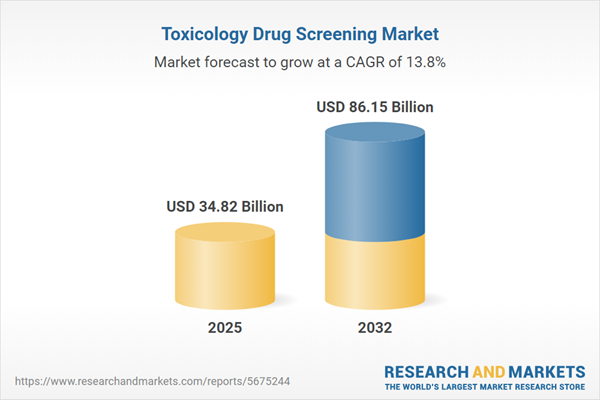Speak directly to the analyst to clarify any post sales queries you may have.
The toxicology drug screening market is evolving rapidly, propelled by advancements in technology, regulatory demands, and shifting business models. Senior stakeholders face both heightened complexity and expanding opportunities as laboratories adopt innovative approaches to detection and compliance.
Market Snapshot: Growth Trajectory of the Toxicology Drug Screening Market
The global toxicology drug screening market grew from USD 30.59 billion in 2024 to USD 34.82 billion in 2025 at a CAGR of 13.81%, projected to attain USD 86.15 billion by 2032. This pace is driven by rising demand for advanced screening methods, increased regulatory oversight, expansion across clinical and non-clinical settings, and greater investment in automation and analytics.
Scope & Segmentation of the Toxicology Drug Screening Market
This comprehensive report provides in-depth coverage of the toxicology drug screening industry, dissecting the market through detailed segmentation and a regional perspective.
- Test Types: Chromatography and mass spectrometry, including gas and liquid chromatography platforms; immunoassay; molecular diagnostics such as next-generation sequencing and PCR-based testing; rapid testing solutions.
- Product Types: Chromatography systems; confirmation services; consultation services; enzyme-linked immunosorbent assay kits; lateral flow immunoassay kits; mass spectrometers; PCR instruments; screening services.
- Sample Types: Blood (including plasma and whole blood); hair; oral fluid; saliva; urine.
- Drug Classes: Amphetamines; benzodiazepines; cannabis; cocaine; opiates.
- Applications: Clinical diagnostics; forensic testing; pain management; sports anti-doping; workplace testing.
- End Users: Government and military laboratories; home care testing; hospitals and clinics; independent laboratories; research institutes.
- Geographic Coverage: Americas (United States, Canada, Mexico, Brazil, Argentina, Chile, Colombia, Peru); Europe, Middle East & Africa (United Kingdom, Germany, France, Russia, Italy, Spain, Netherlands, Sweden, Poland, Switzerland, United Arab Emirates, Saudi Arabia, Qatar, Turkey, Israel, South Africa, Nigeria, Egypt, Kenya); Asia-Pacific (China, India, Japan, Australia, South Korea, Indonesia, Thailand, Malaysia, Singapore, Taiwan).
- Company Coverage: Thermo Fisher Scientific Inc.; Abbott Laboratories; F. Hoffmann-La Roche Ltd.; Siemens Healthineers AG; Agilent Technologies, Inc.; Shimadzu Corporation; PerkinElmer, Inc.; Waters Corporation; Bio-Rad Laboratories, Inc.; Randox Laboratories Ltd.
Key Takeaways for Senior Decision-Makers
- Integrating advanced analytical technologies and automation is transforming accuracy, operational efficiency, and turnaround times across laboratories and service providers.
- Strategic collaborations, particularly between instrument and software manufacturers, are accelerating the adoption of artificial intelligence and predictive analytics in testing workflows.
- Molecular diagnostics and rapid testing are broadening market reach into new settings, including home care and decentralized clinics, meeting growing needs in occupational health and sports compliance.
- Diversification of supply chains and dual-sourcing arrangements are emerging as vital risk mitigation strategies in response to global tariff changes affecting crucial raw materials and instrumentation.
- Regional market disparities, shaped by regulatory standards and infrastructure maturity, require localized strategies to balance cost efficiency, technology adoption, and compliance.
- Market leaders combining hardware, software, and expert services are establishing end-to-end solutions that enhance customer value and brand differentiation.
Tariff Impact on Supply Chains and Cost Structures
Revised United States tariffs effective in 2025 have led to increased supply chain complexity, especially for raw materials and analytical instruments. Organizations are mitigating risk by adopting procurement diversification, negotiating longer contracts, and reassessing international sourcing. These adaptive strategies foster operational agility and highlight ongoing shifts toward supply resilience and cost containment throughout the toxicology drug screening ecosystem.
Methodology & Data Sources
Findings presented in this report result from a robust combination of primary and secondary research. In-depth interviews with industry leaders, laboratory directors, and regulatory bodies were complemented by an extensive review of industry literature, peer-reviewed journals, and trade association insights. Triangulated data validation ensures analytical objectivity and practical relevance for executive decision-making.
Why This Report Matters for B2B Stakeholders
- Enables C-suite and procurement leaders to benchmark competitive strategies, technology shifts, and regulatory responses worldwide.
- Supports operational planning with granular market segmentation and actionable insights tailored for evolving compliance demands.
- Equips business development teams with essential data for identifying growth opportunities and forming effective partnerships across regions and sectors.
Conclusion
The toxicology drug screening market is experiencing fundamental transformation, driven by innovation, regulatory change, and global collaboration. This report empowers decision-makers to navigate challenges and seize emerging opportunities with confidence and clarity.
Additional Product Information:
- Purchase of this report includes 1 year online access with quarterly updates.
- This report can be updated on request. Please contact our Customer Experience team using the Ask a Question widget on our website.
Table of Contents
3. Executive Summary
4. Market Overview
7. Cumulative Impact of Artificial Intelligence 2025
Companies Mentioned
The companies profiled in this Toxicology Drug Screening market report include:- Thermo Fisher Scientific Inc.
- Abbott Laboratories
- F. Hoffmann-La Roche Ltd.
- Siemens Healthineers AG
- Agilent Technologies, Inc.
- Shimadzu Corporation
- PerkinElmer, Inc.
- Waters Corporation
- Bio-Rad Laboratories, Inc.
- Randox Laboratories Ltd
Table Information
| Report Attribute | Details |
|---|---|
| No. of Pages | 193 |
| Published | October 2025 |
| Forecast Period | 2025 - 2032 |
| Estimated Market Value ( USD | $ 34.82 Billion |
| Forecasted Market Value ( USD | $ 86.15 Billion |
| Compound Annual Growth Rate | 13.8% |
| Regions Covered | Global |
| No. of Companies Mentioned | 11 |









